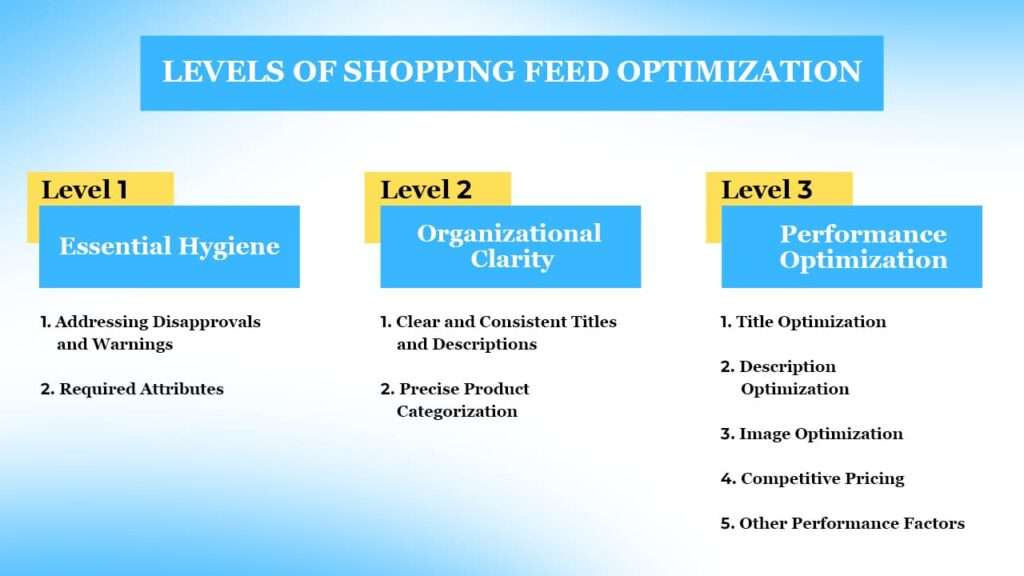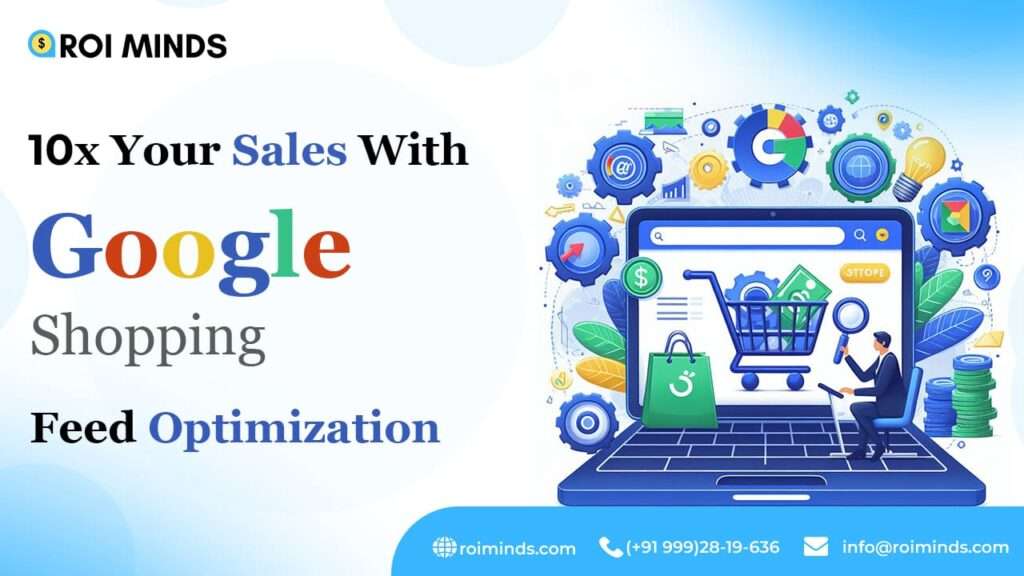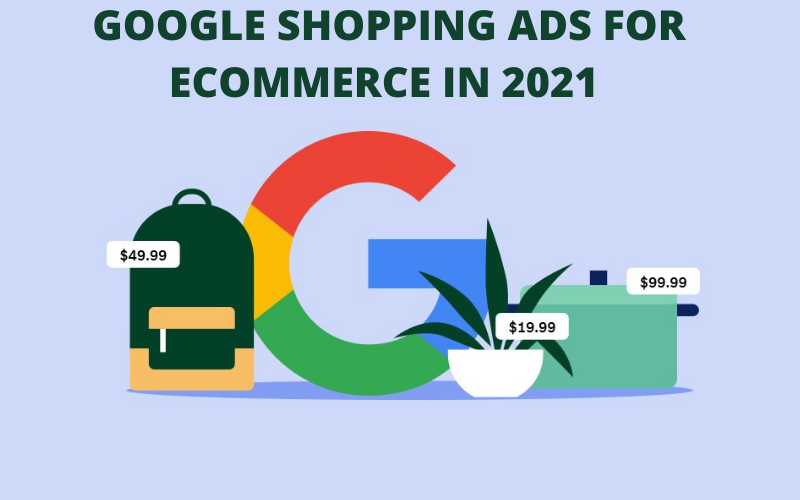Have you ever wondered why Google is the undisputed king of search engines? Google is constantly innovating to become a one-stop shop for consumers and businesses. With 89.3 billion monthly visits, Google understands the power of connecting people with what they need.
For businesses like yours, that connection can mean the difference between booming sales and struggling to be seen. That’s where Google Shopping comes in – a tool for putting your products front and center for millions of shoppers.
Do you know that nearly half of all product searches begin on Google? And with online shopping expected to rise by 2040, the future is undoubtedly digital. Understanding shopping feed optimization is crucial for your business to thrive in this ever-evolving online marketplace.
To truly stand out and capture the attention of potential customers, you need to optimize your feed. This article will equip you with essential tactics for Google product feed optimization.
WHAT IS GOOGLE PRODUCT FEED?
It’s a document containing all the information about your products, such as titles, descriptions, prices, and images. This data acts as a communication channel between your store and Google. It allows them to understand what you’re selling and how best to display it to interested shoppers.
Product data feed optimization is a powerful tool beyond simply listing your products. Google uses this information to showcase its offerings across various platforms. The more organized your feed is, the wider your reach and easy access to connecting with potential customers.
Creating your feed is easy! Google provides clear guidelines on formatting the data, often in user-friendly formats like XML or CSV files. It is then uploaded to Google Merchant Center to manage all your campaigns. You can ensure the accurate product information, categorize your offerings effectively, and even monitor their performance.
IMPORTANCE
You set up a user-friendly online store and invest in social media marketing. But despite your efforts, sales remain the same. Your Google Shopping product feed might be a hidden barrier preventing potential customers from discovering your amazing products.
Think of your feed as the shop window on your virtual storefront. A messy, cluttered window with inaccurate information won’t allow shoppers to view your website. It is where product data feed optimization helps transform your feed into a display that attracts clicks and conversions.
Why Optimize? Google Shopping relies heavily on the information you provide in your product feed. It determines when and where your products appear in search results. An unoptimized feed with missing key details can lead to your products getting lost in the digital shuffle.
A well-structured feed with clear, concise titles and captivating descriptions attracts shoppers to click on your product listings. It transforms to more website traffic and potential customers.
Don’t underestimate the power of accurate and relevant information. An optimized feed ensures customers see what they’re getting. It leads to fewer surprises and more satisfied buyers who convert their interest into sales.
Investing in product data feed optimization gives your virtual salesperson the tools they need to shine. A well-optimized feed empowers them to showcase your products effectively, leading to a booming online business!
BENEFITS
By implementing a strategic feed optimization plan, you can transform your virtual storefront into a vibrant marketplace, attracting shoppers and boosting your sales.
1. Increased Visibility:
It acts like a giant search engine specifically for products. However, unlike a physical store window, Google Shopping relies on the information you provide in your feed. This data acts as a roadmap, guiding shoppers to discover relevant searches.
With relevant information and captivating descriptions, your products are more likely to appear at the top of search results. It transforms into a dramatic increase in visibility, taking your products from hidden gems to front-and-center showstoppers.
2. A Seamless Experience:
But Google feed optimization goes beyond just getting noticed. Think of it as creating a welcoming and informative environment for potential customers browsing your virtual store. By providing accurate and detailed information about your products, like size charts, material descriptions, and care instructions, you empower shoppers to make informed decisions.
Furthermore, you can optimize it by categorizing products logically and using quality images. It means no more frustrated customers spending ages searching for the right product or squinting at blurry photos.
3. Booming Sales and Revenue:
By increasing your product visibility, you attract a wider audience and increase your chances of converting casual browsers into customers. Utilize the power of strategic Google feed optimization techniques to boost sales. Imagine a steady stream of interested shoppers discovering your products, enjoying a smooth buying journey, and clicking that “purchase” button.
LEVELS OF SHOPPING FEED OPTIMIZATION
You need a well-optimized feed to truly stand out and attract clicks. Shopping Feed Optimization your feed isn’t just a one-time fix; it’s a multi-layered approach. Here’s a breakdown of the three key levels to optimize shopping feeds:

Level 1: Essential Hygiene
1. Addressing Disapprovals and Warnings:
Google Merchant Center might flag your product feed with disapprovals or warnings if it does not meet certain requirements. These messages act as helpful reminders to fix errors before it appears on Google Shopping. Ignoring them can lead to limited product visibility – not ideal!
Example: You might receive a message for missing information, such as a product’s GTIN.
2. Required Attributes:
Think of product attributes as the building blocks of your product information. Google needs specific data points for each product to understand what you’re selling and display it accurately. It requires a powerful technique, such as product data feed optimization, to help boost sales. It includes essential information like:
- Title: A clear and concise description of your product.
- Description: An explanation of the product’s features.
- Image URL: A link to a high-quality image of your product.
- Price: The current selling price of your product.
- Brand: The manufacturer or brand of your product.
- GTIN: A unique identifier for your product (often required for specific categories).
Example: Imagine you’re selling a pair of handcrafted leather sneakers. Essential attributes would include “Handcrafted Leather Sneakers” for the title. A detailed description mentioning the leather type, sole material, and comfort features. A high-resolution image showcasing the sneakers from different angles. If you have one, the current price, your brand name, and potentially the GTIN.
Solution: Double-check your feed to ensure all one includes the required attributes for each product. It involves exporting data from the store and reviewing it before uploading it to Google Merchant Center. You can use strategic Google feed optimization techniques to help you achieve your goals.
Level 2: Organizational Clarity
Now that your feed meets the goals, it’s time to organize it. It is like arranging your products logically within your shop window for a clean and visually appealing display.
1. Clear and Consistent Titles and Descriptions:
Standardize how you write your product titles and descriptions. Consistency makes your product feed easier to manage and ensures potential customers can quickly understand your offering.
- Example: Imagine you sell a variety of hats. Don’t title some hats “Black Beanie” and others simply “Beanie.” Standardize them as “Black Cotton Beanie” and “Navy Wool Beanie” for better clarity.
- Solution: Choose a product name with relevant keywords, key features, and brand identifiers. It ensures consistency throughout your feed and makes it easier for customers to search and find what they’re looking for.
2. Precise Product Categorization:
Google Shopping offers pre-defined product categories. Utilize these categories accurately to ensure your products appear in relevant searches. You can use product data feed optimization techniques to help with the same.
- Example: Don’t categorize a “Black Cotton Beanie” under “Winter Accessories.” A more accurate category would be “Hats > Beanies.”
- Solution: Carefully review Google’s product category taxonomy and assign each of your products the most relevant category.
Level 3: Performance Optimization
Now comes the exciting part—transforming your basic feed into a conversion magnet! It is where you take the display to the next level, attracting customers to explore further.
1. Title Optimization
Your product title is the first thing a potential customer sees in a Google Shopping search. Create so that it is informative and attention-grabbing. Shopping feed optimization techniques can help you improve the performance of your feed.
a) Keyword Magic:
Use relevant keywords throughout your product titles. Remember, keywords are words or phrases people use to search for products online. Including relevant ones increases the chances of your products appearing in search results. Avoid keyword stuffing! Titles that are overly stuffed with keywords can seem unnatural and deter clicks.
b) Highlights:
Don’t just list features – showcase the benefits! Optimize shopping feeds by considering what makes your product unique and how it solves a customer’s problem. Briefly weave these benefits into your titles.
c) Title Length:
Google recommends keeping titles under 70 characters to ensure they display fully in search results. It might seem short but it is impactful.
2. Description Optimization
Your product description is an opportunity to tell a story about your product and its benefits. It’s like having a friendly salesperson explain why your product is a perfect choice.
a) Bullet Points:
Bullet points can help provide specifications, but additional information goes beyond. Use shopping feed optimization techniques to tell a story about your product and how it can enhance a customer’s life.
Example: Instead of listing just the material and size, describe the soft cotton and the comfortable fit.
b) Readability:
Remember those relevant keywords? While readability is important, use them naturally throughout. It helps Google understand your product and increases the chances of it appearing in relevant searches.
Example: Mention the material and the color to emphasize relevance.
c) USP:
Every product has a unique selling proposition (USP) – what makes it stand out from the competition? Don’t be shy about highlighting your USP in your description.
Example: Local artisans may have ethically sourced and hand-crafted your product. Mention this in your description as a unique selling point that might relate to customers who value ethically made products.
3. Image Optimization
Think of your product images as eye-catching displays in your shop window.
a) High-quality image:
Invest in professional-looking product images. Blurry, low-resolution images create a poor first impression and deter potential customers.
Example: Imagine a blurry image of a black blob – who would click on that? A clear, high-resolution image showcasing the beanie’s texture, color, and details would be much more interesting.
b) Clean Backgrounds:
Let your products take center stage! Use clean and uncluttered backgrounds that don’t distract from the product itself.
Example: Avoid cluttered backgrounds with logos, text, or other visuals that compete with the product for attention. A plain white background or a background similar to your shop environment is ideal.
c) Multiple Angles:
Don’t limit yourself to a single image. Offer high-quality photos from different angles to showcase your product’s details and functionality.
Example: For the product, include a front view, a back view, and a close-up view showcasing the material texture. Consider showing a model wearing the same.
4. Competitive Pricing
Price is a major factor influencing online shopping decisions. Here’s how to strategically price your products for maximum sales potential. Optimize shopping feeds using the below steps:
a) Monitor the Competition:
Research competitor pricing for similar products. It gives you a benchmark to assess your pricing strategy.
Example: Find out what other brands are charging for black cotton beanies.
b) Price it Right:
When setting cost, consider target audience, production, and your margin. It will ensure profitability.
Example: If investing in high-quality materials, you might price it slightly higher than a mass-produced beanie. Ensure the difference is justifiable and communicated through description.
c) Promotions:
Use shopping feed optimization techniques, such as Sale Price and Special Offers, to highlight any current promotions or discounts you’re offering.
Example: You’re offering a discount on your black cotton beanies during a winter sale. You can utilize your feed’s “Sale Price” feature to make it stand out in search results.
5. Other Performance Factors
a) Accurate Shipping Information:
Provide clear and accurate information about your shipping rates and delivery times. It builds trust with potential customers and helps them make informed purchase decisions.
b) Clear Return Policies:
Outline your return and exchange policies clearly in your product descriptions and website. It gives customers peace of mind, knowing their options if they need to return an item.
c) Regular Feed Updates:
Don’t let your feed become dull! Regularly update your product information with any changes in price, availability, or descriptions. It ensures customers see the most accurate and up-to-date information.
CHALLENGES
- Google Shopping thrives on a well-defined data structure. It is a specific language your product information needs to speak to be understood by Google. One of the initial hurdles many businesses face is ensuring their product feed follows all these criteria. By familiarizing yourself with Google’s product data specifications, you can create a feed that effectively showcases your products.
- You’ve meticulously crafted your feed, only to have Google reject it. The reasons behind rejection include mismatched data across your website and your feed and inconsistencies with pricing.
- Listing your products on Google Shopping is just the first step. To truly reap the benefits, you need to optimize shopping feeds. It simply refers to fine-tuning your product titles, descriptions, and categories. Think of it as creating irresistible product listings that attract potential customers and encourage clicks.
CONCLUSION
The digital marketing landscape offers a wealth of opportunities to connect with potential customers. You can transform any online platform into a thriving marketplace by harnessing the power of Google feed optimization strategies.
Remember, the key lies in presenting your products in the best possible light. Invest in optimization, tailor your content, and leverage the power of data to ensure your offerings reach the right audience. By taking these steps, you’ll pave the way for increased visibility, improved conversions, and a flourishing online presence.
FAQ’s
One can boost sales by optimizing their product feed. One can create listings that attract buyers by optimizing your feed with relevant keywords.
Crafting clear, keyword-rich titles is crucial for Google Shopping success. Product title optimization involves incorporating relevant search terms customers might use to find your products. It increases your chances of reaching a vast audience.
Optimize shopping feeds using the below steps:
1. Ensure your feed includes details like titles, descriptions, prices, and images.
2. Incorporate relevant keywords and write concise descriptions for your product.
3. Organize your products using relevant Google Shopping categories for easy browsing.
4. Regularly update your feed regarding pricing, availability, or product details
Here are some tips for shopping feed optimization:
1. Leverage Merchant Center’s diagnostic tools to identify and fix any errors in your feed.
2. Track key metrics to see what’s working and what needs improvement.
3. You can test titles, descriptions, and images to see what resonates best with your target audience.ience.
The best practices for shopping feed optimization involve a data-driven approach. Focus on providing accurate and relevant product information. Prioritize clear communication, descriptions, and quality visuals to capture attention.
Local product inventory feeds require specific attributes related to your physical store location. It includes your store address, phone number, and other information.
It is the process of improving the data you provide to platforms like Google Shopping. By optimizing your feed, you ensure your products lead to increased visibility and better sales.





